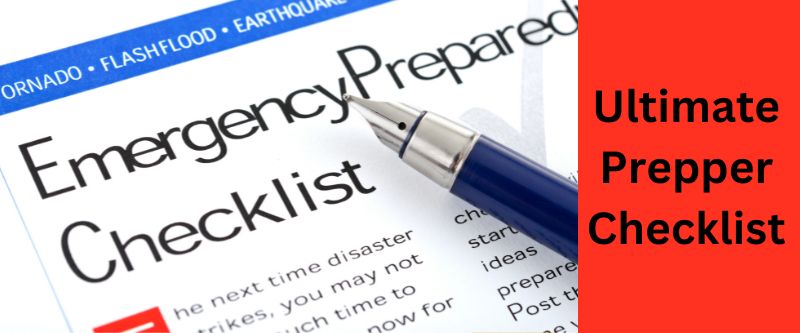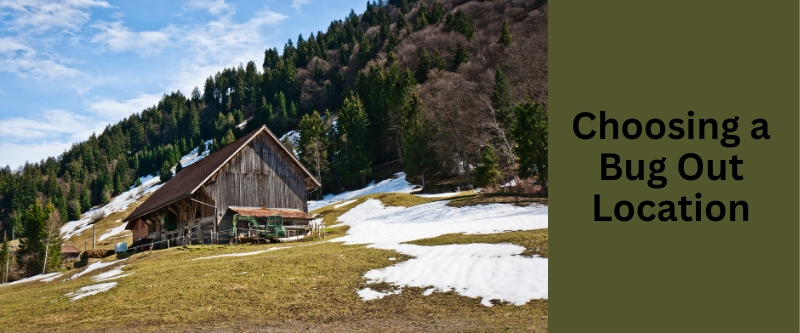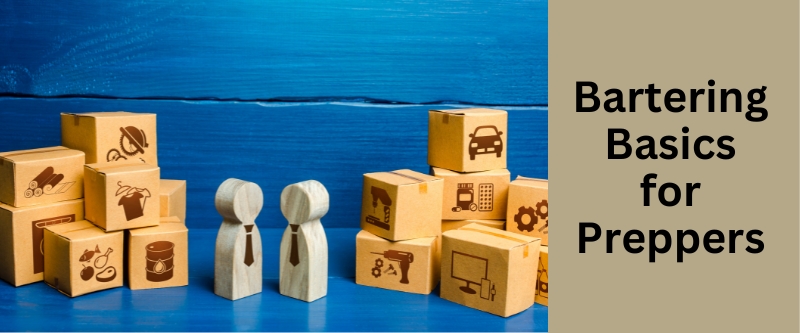Table of Contents
Prepper Checklist – 101
A checklist like this is just a memory jogger and food for thought. When it comes to an emergency and the stuff we need to make it through, so much depends on the dictates governing one’s initial strategy, the type and degree of the emergency, and one’s own personal preferences.
And, of course, the emergency can range from an inconvenient power outage to an all-out, hair-on-fire, SHTF scenario.
From Hunkering Down to Bugging Out
In our case, we look at prepping and survival as a progression. We plan to hunker down at home and only bug out with whatever we can load in a car or carry on foot, if we are forced to. Now we live in a rural area and have prepared our home accordingly. But we are also ready to leave on foot and attempt to survive elsewhere, if there is no other option but bugging out.
The dictates of every situation are different and every individual must plan accordingly.
DIctates of Home Location
A great deal of decision making on necessary supplies depends on where home is. Hunkering down in a home with acreage in a rural setting is much more doable than hunkering down in an apartment in an urban setting, which could become untenable much faster.
In fact, from the perspective of the apartment dweller, someone who lives in the boonies is already bugged out.
Dictates of the Emergency and its Duration
On the other hand, a home in a rural setting but in a low lying area near the coast is no match for a hurricane, which would make hunkering down a stupid decision and dictates an immediate evacuation. But in this case there is at least the expectation of returning home.
So individual prepping plans must consider the types of emergencies that may be encountered. These will include the locally focused geographic areas that are at risk from hurricane, tornado, flood, extreme heat, winter storm, and earthquake.
They will also include universally applicable risks of power and water supply outages, civil unrest, EMP (electromagnetic pulse) disruptions, epidemic, and war.
In addition the prepper must consider the potential duration of the emergency. Will it be short or long term? In our personal opinion a short term emergency could last 3 months and this is the bare minimum for which one should be prepared.
Dictates of Home and Family Size
The size of one’s home (apartment, mobile home, single family home, ranch) plus the size and make-up of one’s family (children, grandparents) are also major considerations in making plans.
The point is that the well prepared prepper must consider all eventualities and circumstances.
Using the Checklist
This means that this checklist needs to cover all bases. So we lay things out in broad categories, starting with the survival triad of shelter, food and water.
But within all these categories it is up to the individual to take into account both hunkering down at home (in urban, suburban, and rural settings) and also bugging out and making it on the move.
This means we need to distinguish between what we can comfortably have at home, on one hand, and what we can realistically take with us, on the other. And by realistic, it may be that one must bug-out on foot without the luxury of transportation.
Organization and Storage of Supplies
Food Shelf Life
Identify the shelf life of food and rotate accordingly. This means that you need to track “use by” and “expiration” dates. Use spreadsheets and labeling. Segregate long, medium and short-term storage items
Be conscientious about this or you will waste food and potentially risk harm to yourself and family. You want to be confident that the food you stored is usable.
Secure Storage
In an emergency scenario the social fabric can fall apart. This means that you need to keep your supplies and essential equipment safe from predators. Use hidden compartments or other stashes on your property.
Redundancy & Back Up
One last point before we get to the checklist. In all cases of equipment and supply selection, try to build in as generous back-up as possible. For example, have three methods of cooking food available to you. Have three sources of artificial light on hand. Have at least three methods of water storage.
Organization of this Checklist
In order to keep this list as short as possible, we have tried to avoid unnecessary repetition. But please know that many of the individual items we have listed here belong in more than one category.
Of course, the famous bug out bag and the lesser known ancillary everyday carry or get home bag are in a category all their own and duplication there is necessary.
Shelter
The concept of shelter is foundational in prepping. It is the cornerstone for survival in both short-term and long-term scenarios. Whether you are planning to “bug in” at home or “bug out” to a remote location, having a secure and functional shelter can make all the difference.
Shelter provides protection from the elements and a base for other survival activities. It also provides some sense of security. In the event of a disaster like an earthquake, your home may become uninhabitable, but alternative shelter options like camping in your backyard could still be viable.
The point is that in a bugging out scenario, you are not immediately transported to some remote wilderness, which might be days away. You have to plan for what will be in front of you.
Shelter at Home
- Home Security/Early-Warning System
- Motion-sensing cameras and automatic lighting
- Remote-adjustable video/audio systems
- Home alarm
- Smoke and carbon monoxide detectors and batteries
- Fire extinguishers
- Fuel and kindling for fireplace/woodstove
- Emergency/portable lighting and replacement batteries/chargers
- A get-home bag (Consider including a bivvy-type sleeping bag)
- Gas generator (include fuel, accessories, cables, and maintenance tools)
- Solar panels, chargers, batteries, and accessories
- Wind power generation equipment and accessories
- AC inverters
- Batteries/chargers for all devices
- Hand-cranked generator
- Self-sufficiency supplies
Shelter Bugged Out
- Good quality, weather-resistant tent suitable for your family size
- Tent repair and replacement parts
- Camping mattress
- Sleeping bags rated for your likely climate condition
- Heavy-duty tarps, 550 paracord, bungee cords
- Poncho/rain slickers
- Emergency blankets
- Sturdy clothing: Thermal layers, waterproof jackets, and hat
- Sturdy boots
- Bivy/sleeping bags and ground mats
- Tarps, 550 cord, bungee cords
- Tent(s), repair and replacement parts
- Solar Panels (Portable models are available)
- Hand-cranked generator
- Batteries (Various sizes, including rechargeable models)
Food
In the realm of prepping, food is one of the most critical components for survival. A well-thought-out food storage and preparation plan can be the difference between life and death in emergency situations. The key is to have a variety of food items that are not only nutritious but also have a long shelf life.
This includes non-perishable items, canned goods, and specially prepared foods like MREs (Meals Ready to Eat). Additionally, the means to procure, prepare, and cook food are important too.
Whether you’re in the comfort of your home or out in the wilderness, having the right food and cooking supplies can make your survival more manageable and less stressful. Refer to this informative authority on emergency food supply and long-term food storage.
Food and Nutrition
- Non-perishable calorie-dense food
- Canned and vacuum-sealed foods
- Cans of powdered milk
- Maple Syrup
- Apple Cider Vinegar
- MREs (Meals Ready to Eat)
- Proprietary emergency food products (Patriot Supply, Auguson Farms)
- Cooking oils
- Cooking powders (baking soda, flour, etc.)
- Dairy products, dry
- Eggs, dry
- Freeze-dried entrées and meals
- Fruit (canned, dried, preserved)
- Grains and cereals
- Pasta
- Canned fish, meat, poultry
- Canned vegetables
- Protein, plant (beans, lentils, nuts, powdered mixes)
- Rice
- Salt, iodized
- Seeds for planting and consumption
- Soups and stews
- Sweeteners (agave, honey, sugar, etc.)
- Vegetables (canned, dried, preserved)
- Freeze-dried chicken
- Freeze dried ground beef
Food Storage
Food Procurement
- Hunting and trapping equipment
- Fishing rod, tackle, and accessories
Food Preparation and Eating
- Solar oven or wood stove
- Portable camping stove
- Cooker, stove, and fuel (if gas-powered)
- Outdoor Cook Stove (A budget-friendly stove for cooking)
- Can opener
- Cooking utensils (knives, tongs, spatulas, etc.)
- Eating utensils, dishes, mess kits
- Pans, pots, grills, and other cooking implements
- Seasonings and spices
- Mess Kit/Camp Cookware (Stainless steel or titanium cookware)
Water & Hydration
Allowance: Minimum one gallon of drinking water per person, per day.
Water Storage (Static)
- IBC Container, 30- 55-gallon barrels, Jerry cans, (BPA-free, food grade)
- Tanks, cisterns, large capacity bladders
- Water resupply plan
Water Storage (Portable)
- Portable water containers (1 to 5 gallons)
- Water bottles (BPA-free food grade or stainless steel)
- Hydration backpack
- Portable bladders
Water Treatment
- Water filtration devices (Sawyer Mini, LifeStraw)
- Carbon filter jugs
- Water purification tablets
- Water preservative
- Chemical disinfectant, Chlorine bleach
- Chemical disinfectant supplies
- Heat source and fuel for boiling water
- Ultraviolet water sterilizer
- Water filter/purifier (at least one device per person)
- Water flavoring (to improve the taste of treated water)
- Water preservative
Fire, Heat, Light & Power
In a survival situation, the ability to create fire, generate heat, and produce light are essential skills and resources.
- Fire serves multiple purposes: it can keep you warm, cook your food, purify water, and signal for help.
- Light is crucial for navigation and performing tasks in the dark.
- Heat is vital for maintaining a comfortable living environment.
- Power is (in part) what fuels heat and light.
This category covers various tools and supplies that can help you achieve these objectives.
Fire and Heat
- Disposable or refillable lighters (various sizes and types), replacement fuel
- Ferrocerium rods and strikers (various sizes and carry methods)
- Flint and striker
- Magnesium fire starters and scrapers
- Magnifying glass with cover
- Waterproof matches in a weatherproof container with a striker
- Commercially made tinder
- Homemade tinder
- Weatherproof tinder container
- Wood for kindling
- Portable propane heater
- Space heater
- Wood-fired box stove
- Chimney kit for wood stove installation
Light
- Flashlights (battery-operated and hand-cranked models)
- Headlamps
- Battery-powered lantern
- Batteries for all devices
- Chemlights
- LED reading lamp
- Optics for use during the day or night
Cooking
- Propane gas camp stove
- Extra propane cylinders
- Open fire cooking grate
- Dutch oven
- Cooker, stove, and fuel (if gas-powered)
- BBQ (wood, charcoal or propane). Make sure there is spare fuel
Power
- Generator plus fuel
- Solar chargers
- Batteries
Additional Items
- Candles, matches, lighter, and fire starters for lighting and fire-making
- Kerosene pressure lamp with fuel
- Survival blanket: Emergency Mylar thermal blankets
- Mess kit/camp cookware: Stainless steel or titanium cookware
- Outdoor cook stove: A budget-friendly stove for cooking
- LED flashlights and batteries: A quality flashlight that can withstand harsh environments
Clothing
Clothing is a critical aspect of prepping that often gets overlooked. The right clothing can protect you from the elements, keep you warm or cool, and even shield you from hazards like insects and snakes.
Whether you’re in a bug-out situation or hunkering down at home, your clothing choices can make a significant difference in your comfort and safety. Remember that, even if you are hunkering down at home, the power may be out.
Layering System
- Base Layer: Moisture-wicking fabric to keep you dry
- Mid-Layer: Insulating layer for warmth
- Street Clothes: Suited to the weather and situation
Specialized Clothing
- Hunting/Camouflage Clothing: For hunting and stealth
- Insect and Snake Protective Clothing: To protect against bites and stings
- Weather-Protective Outerwear: Waterproof and windproof jackets, pants, and accessories
Footwear
- Sturdy Boots or Trail Shoes: For various terrains
- Winter Socks: For cold weather
- All-Purpose Socks: For general use
Head and Hand Gear
- Stocking Caps: For cold weather
- Hat and Bandanas: For sun protection
- Sunglasses: To protect your eyes from UV rays
- Gloves and Mittens: For hand protection and warmth
- Sunscreen: For sun protection
Winter Essentials
Remember, it is cold not heat that kills.
- Winter Parka: For extreme cold
- Gloves: Insulated for cold weather
- Winter Socks: Extra warm for cold conditions
Additional Items
- Sleeping Bags: Rated for various temperatures
- Sturdy Clothing: Thermal layers, waterproof jackets, and hats
- Socks and Underwear: Extra pairs for hygiene
- Gloves and Mittens: For different weather conditions
Always consider the specific needs of your location and situation when selecting clothing. The right clothing can make a significant difference in your ability to stay comfortable and safe in any survival scenario.
Health & Medical Supplies
Health and medical supplies are central to being prepared. Whether you’re dealing with minor injuries, chronic conditions, or emergency medical situations, having the right supplies can make all the difference.
Information is also critical. See The Survival Medicine Handbook.
From first aid kits to prescription medications, this category covers a broad range of items that can help you manage health-related issues in various scenarios.
Vital Medications and Prescriptions
- 90 to180-day supply of all vital medications: For chronic conditions and essential needs
- Prescription Eyewear: Extra pairs for vision
- Epinephrine Pen Kits: For severe allergic reactions
First Aid Kits and Trauma Supplies
- Home First Aid Kit: Upgraded for your specific needs
- Individual First Aid Kit: One per person, for personal use
- Minor Trauma Kit: Includes bandages, gauze, tourniquets, and antiseptic
- Suture and Trauma Kit: One per person, for severe injuries
- Snake Bite Kit: One per person, for venomous snake bites
- Burn Kit: For treating burns
- Expedition Level First Aid Kit: For extended trips and severe conditions
- Trauma Kits and Trauma Supplies
Specialized Medical Equipment
- Backboard or Other Type of Litter: For immobilizing and transporting injured persons
- Neck Brace and Assorted-Sized Splints: For immobilizing fractures and neck injuries
- Slings and Triangle Bandages: For arm and shoulder injuries
- Specialized Equipment: Defibrillator, CPAP, oxygen supply, and accessories
Hygiene and Sanitation
- Toilet Paper: For personal hygiene
- Paper Towels: For cleaning and hygiene
- Hand Sanitizer: For hand hygiene
- Hand Soap: For washing hands
- Disinfectant Floor Cleaner: For sanitation
- Feminine Hygiene Products: For menstrual care
- N95 Masks: For respiratory protection
- Toothpaste: For oral hygiene
- Mouth Wash: For oral hygiene
Additional Supplies
- Blankets: Compact/packable and traditional, for warmth and comfort
- Emergency Dental Kit: One per person, for dental emergencies
- Hydrogen Peroxide: For wound cleaning
- Multivitamins: For nutritional supplementation
- Small Mirror: For personal care and medical use
- Light Sticks: For illumination and signaling
- Survival Whistle: With compass, signaling mirror, and lanyard
Always consult with healthcare professionals when preparing medical supplies, especially prescription medications and specialized equipment.
Tools and Equipment
In any emergency situation, having the right tools can make a significant difference. Whether it’s for building a shelter, making repairs, or defending yourself, a well-equipped toolbox is essential. Tools not only facilitate various tasks but also can be life-saving in certain situations. Here’s a sorted and organized checklist to help you assemble your tools and equipment for different needs.
Cutting and Sharpening Tools
- Survival Knife: A decent quality, all-purpose knife for various tasks.
- Bushcraft Knife: More than one suggested, along with sharpeners.
- Wood Saw: For cutting wood.
- Timber Saw: For larger woodcutting tasks.
- Utility Knife & spare blades: For everyday cutting needs.
- Tactical Pen: For writing and self-defense.
- Sharpenin steel
- Saw blade sharpener
- Flat blade sharpener with oil
Striking and Digging Tools
- Sledgehammer: For heavy-duty striking.
- Assorted Hammers: For various tasks.
- Shovels: For digging and moving earth.
- Rakes: for moving dirt.
- Ax: For chopping wood.
- Hatchet: For smaller chopping tasks.
- Prybar: For prying open doors or crates
Fastening and Repair Tools
- Duct Tape: For quick fixes and repairs.
- Nails and Screws: For fastening and building.
- Vise Grips: For holding objects securely.
- Screwdrivers: For screwing and unscrewing.
- Vise: For holding materials while working on them.
- Mechanics Kit: For vehicle and machinery repairs.
Multi-Functional Tools
- Multi-tools/Swiss Army Knife: For everyday tasks and minor repairs.
- Sewing Kit: For fabric repairs.
- Paracord: 100 feet of 550 lb. Type III Nylon Paracord for various uses.
- String: for many uses.
- Rope: Paracord or other strong types for multiple uses.
Always remember to keep your tools in good condition and know how to use them effectively. Safety first.
Self Defense
Self-defense should always be a concern but In a survival or emergency situation, especially when civil unrest is a threat, self-defense can become critical fast..
While the primary goal is to avoid conflict, there may be situations where you have no choice but to defend yourself and your loved ones with force..
This category covers a range of options, from lethal to less-than-lethal weapon systems, as well as other self-defense tools and accessories. Proper training and legal considerations are essential when it comes to the use of any self-defense tools.
Lethal Weapon Systems
- Handgun: With spare magazines or speed loaders, ammunition, and accessories.
- Rifle: With spare magazines, ammunition, and accessories.
- Shotgun: With spare ammunition, and accessories.
- Cleaning and Maintenance Equipment: For all firearms to ensure they function correctly.
- Holsters and Carriers: For safe, concealed carry and transportation of firearms.
- Fixed-Blade Survival Knife: For various tasks and self-defense.
- Smaller Survival Knife: E.g., Morakniv Companion.
- Folding Pocket Knife: For everyday carry and utility.
Less-Than-Lethal Weapon Systems
- Personal-Defense Spray/Tear Gas: Dispenser and replacement cartridges.
- Stun Gun or Taser: With replacement batteries, projectiles, and accessories.
- Restraint Systems: Handcuffs or zip ties for restraining threats.
- Clubs and Axes: For self-defense without firearms.
- Pepper Spray: For immediate self-defense against attackers.
Self-Defense Accessories
- Body Armor: Bulletproof vests or plates for added protection.
- Night Vision Goggles: For nocturnal operations.
- Tactical Pen: For writing and self-defense.
This checklist aims to cover a wide range of self-defense options. It’s crucial to understand the legal implications of carrying and using these tools, especially firearms. Always prioritize de-escalation and avoidance over confrontation, and seek proper training for the effective and safe use of all self-defense tools.
Communication, Transportation & Navigation
In a crisis situation, communication, transportation, and navigation are vital components of a comprehensive preparedness plan. Whether it’s staying in touch with family members, navigating through unfamiliar terrain, or transporting essential supplies, these elements can make a significant difference in your safety and well-being.
Communication Devices
- Amateur/Ham Radio, CB Radio, Multiband Scanner, Walkie-Talkies: With accessories for long-range communication.
- Cell Phone and Accessories: Spare cell phone, batteries, and chargers.
- Computer/Laptop/Tablet: With accessories for data storage and communication.
- Faraday Cage or EMP-Protective Containers: To protect electronic devices.
- FM/AM/SW/Weather Radio: With batteries and accessories.
- Crank-Powered NOAA Emergency Radio
- Satellite Phone: For communication when cell service is unavailable.
- Television: With reception gear and accessories for news updates.
- Two-Way Radios (FRS/GMRS): With batteries and accessories for group communication.
Navigation Tools
- Addresses/Coordinates: Of important places for quick reference.
- Binoculars/Monocular: For scouting and observation.
- Compass: For basic navigation.
- GPS Unit: With batteries and accessories for precise location tracking.
- Map Cases and Markers: For marking routes and points of interest.
- Pace-Counter Beads: For distance estimation.
- Road and Topographic Maps: For planning routes.
- Smartphone Navigation Apps: For convenient, digital navigation.
Transportation Essentials
- First Aid Kit: Specifically for vehicles.
- Fuels, Fuel Additives, Lubricants, Motor Oil: Both on-site and portable.
- Light Sources: With replacement batteries for visibility.
- Navigation Aids: Maps, compass, and GPS for route planning.
- Replacement Parts: For parts most likely to wear out or break.
- Rescue Aids: Flares, high-visibility panels, air horn, whistles, mirrors.
- Secure Storage: For weapons and ammunition.
- Shelter-in-Place Kit: With food, water, shelter, and fire starters.
- Tools and Repair Items: Wire, zip-ties, and other items useful for field repairs and extrication.
- DIY Tire Fix Kit
- Collapsible Containers
Additional Planning & Information
- Group Emergency Preparedness Plan: With contingencies.
- Local Contact Information: CERT, FEMA, Homeland Security, hospitals, National Guard, Police, Fire, EMS.
Always remember to test your equipment regularly and keep backup power sources for all electronic devices. Proper training and practice are crucial for effective use of many of these tools.
Knowledge, Organization & Planning
In the field of emergency preparedness, knowledge is power. The more you know, the better you can adapt to unforeseen circumstances. This category focuses on the importance of planning, organization, and the acquisition of knowledge to prepare for various emergency scenarios.
It covers everything from emergency plans and tactical gear to essential documents and thought-provoking questions that help you tailor your preparedness strategy. Here’s a sorted and organized checklist to guide you.
Emergency Plans
- Bug-Out Plan and Leave-Behind Note: Detailed plans for quick evacuation.
- Group Emergency Preparedness Plan: With contingencies for various scenarios.
- Local Contact Information:
- Community Emergency Response Team (CERT)
- FEMA/Homeland Security
- Local Hospitals
- National Guard Armory
- Police, Fire, EMS
- 72-Hour Kits or Bug-Out Bags: Pre-packed bags for quick evacuation.
- Evacuation Plans: Detailed routes and destinations.
Planning Prompts
- Sustainability: Planning for the long-term sustainability of supplies like electricity and food.
- Prioritization: Strategies for acquiring essential items first, especially when on a budget.
- Evacuation: Plans for quick evacuation and how your supplies fit into that plan.
- Checklist review
Miscellaneous Essentials
- Maps and Compass: For navigation.
- Rope: Paracord or other strong types for various uses.
- Duct Tape: For quick fixes and repairs.
Documents and Cash
- Personal Documents:Copies of IDs, Insurance Policies, Medical Records: Stored on a thumb drive or other media.
- Cash: In small denominations for emergency transactions.
Bug Out Bag
A Bug-Out Bag (BOB) is designed to sustain you for at least 72 hours and should be easily accessible. It should contain essentials like shelter, food, water, and first-aid supplies.
Trek Bag
Ideally, you should have 2 BOBs. One is for bugging out on foot (Trek-Bag) and should be in a backpack weighing no more than 25% of your body weight. The other is for bugging out in your car or truck (Auto-Bag).
Auto Bag
With the Auto-Bag there is no weight limit, so long as you can physically load it into your car. And with the Auto-Bag, you should max it out with the consumables on this checklist. The Auto-Bag can last you much longer than 72 hours.
If you start buggfing out in your car or truck, pack both bags. Use the contents of the Auto Bag first. The firearms should stay in your Trek Bag. There is no need to duplicate those.
By the way, to our mind the Trek Bag is one and the same as the Get Home Bag (see below), except perhaps for the firearms.
Rather than assemble the BOB yourself, consider these ready-made options:
That said, here is the checklist. Remember that you may need to be filling multiple BOBs.
Water and Hydration
- Drinking Water (3 Liters)
- Collapsible Water Bottle
- Hard Water Bottle
- Metal Water Bottle / Canteen
- Water Filters / Purification Systems
- Water Purification Tablets
Food and Food Preparation
- Protein / Energy Bars
- MREs / Dehydrated Meals
- Spork
- P-38 Can Opener
- Metal Cooking Pot
- Metal Cup
- Pot Scrubber
- Portable Stove
- Stove Fuel
Clothing
- Lightweight Long Sleeve Shirt (made of poly fabric, not cotton)
- Convertible (Zip-Off) Pants
- Underwear
- Merino Wool Hiking Socks
- Medium Weight Fleece
- Hat w/ Flex Brim
- Working Gloves
- Rain Poncho
- Shemagh
Shelter and Bedding
- Tarp
- Tent (Optional)
- Sleeping Bag
- Ground Pad
- Wool Blanket
- Consider a Bivvy Bag
Heat Source
- Lighter
- Ferrocerium Rod fire starter
- Tinder
First Aid
Hygiene
- Wet Napkins
- Hand Sanitizer
- All-Purpose Camp Soap
- Hygiene/Signal Mirror
- Feminine supplies
- Small Pack Towel
- Travel Toilet Paper
- Travel Size Toothbrush & Toothpaste
Tools
Lighting
- LED Headlamp
- Light Glow Stick
- Mini LED Light
- Tea Candles
- Solar Lantern / Charger
- Batteries
Communications
- Primary – Cell Phone
- Alternate – Wifi/Tablet
- Contingency – Ham Radio w/ License
- Emergency – Crank Power Charger/Radio with Signal Lights
Travel Aids
- $500 Minimum in Small Bills
- Quarters
- Gold / Silver Bullion Coins
- Local Area Map
- Compass
- Small NotePad / Pencil
- Emergency Whistle
- Cotton Bandana (Orange)
Self Defense
- Pepper Spray
- Handgun
- Takedown rifle
- Ammunition (Qty 100 rnds min. for each firearm)
Miscellaneous
- 550 Parachute Cord
- Duct Tape (25’)
- 55 Gal. Clear Contractor Trash Bag (Qty 2)
- Resealable Bags (Qty 5, Various Sizes)
- Sunglasses
- N95 Face Mask
- Sewing Kit
- Latex Tubing
- Fishing Kit
- Condoms (Non-lubricated)
- Binoculars
Bug Out Bag Review
Remember, each individual’s needs and situations are different. It’s crucial to assess your circumstances and adjust this list accordingly. Regularly review and update your plans, and make sure all family members are familiar with them.
Get Home Bag / Everyday Carry Bag
This bag has the single purpose of getting us back home. This is where our long-term supplies are and where we will be hunkering down.
Most of us spend about one third of our time away from home, whether at work, casually traveling or running errands. But the point is that emergencies don’t occur on our schedule and we need to be prepared.
For us, and so as not to complicate life, our Get Home Bag is one and the same as the Trek-Bag version of our Bug Out Back (see above). After all, the event that would prompt you to bug out might happen when you are away from home at the office or on an errand.
A Cautionary Note
A number of the items on this bug-out list are appropriate for what one may describe as “Survival Mode.” There are many wonderful websites out there that will help you prepare yourself for survival in the wild but we caution that there is too much unrealistic romanticism attached to the idea of this kind of survival.
Success surviving in the wild takes a great deal of knowledge, training, and lived experience. And this is likely beyond the capabilities and background of the average prepper and family, who are suddenly thrust into a SHTF scenario. You cannot expect to go from a soft and sedentary urban lifestyle and transform yourself into a hardened mountain man overnight.
Bottom line: Nature kills the unprepared and under-prepared. And it does not take prisoners.
So we urge you in your planning to do everything you can to avoid having to make that kind of decision. And if you are in an urban setting we recommend you find in advance somewhere else that is safe to bug out to. You want to bug out to a prepared destination, not into the unknown, where you will be nothing but a refugee.





Leave a Reply